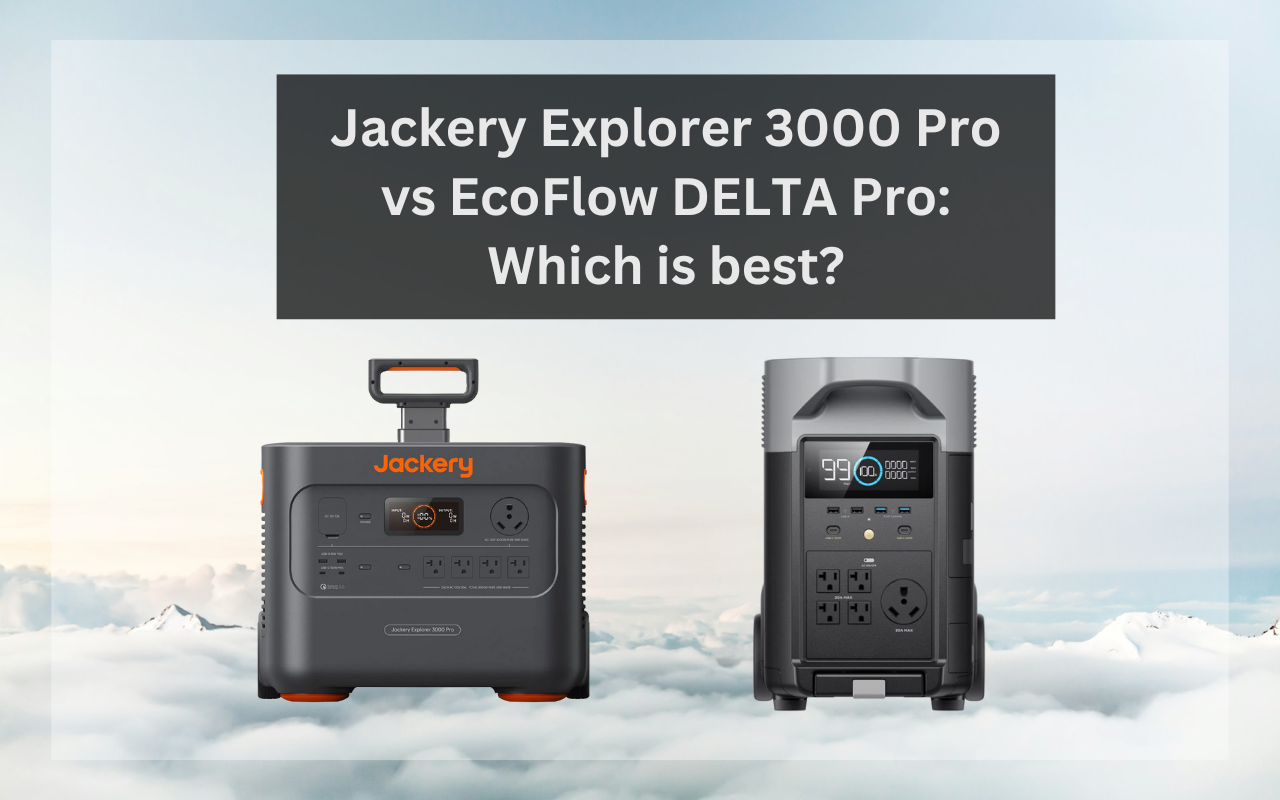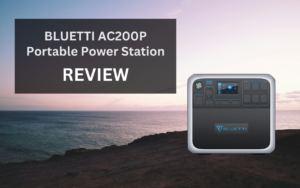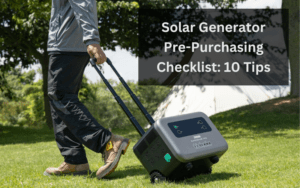Welcome to our product comparison of Jackery Explorer 3000 Pro vs EcoFlow DELTA Pro, where we will analyze the specifications and features of each model to help you determine the best choice for your power needs. Both the Jackery and EcoFlow units are impressive power stations, but they do differ in a number of areas. In this analysis, we will highlight these differences which might influence your decision.
Both models are available to purchase as standalone portable power stations, but portable solar panels and other additional items can be added on to form a larger solar generator kit. We will be discussing the purchasing options later in this article.
Note: While the EcoFlow DELTA Pro is available in the US, Canada, and the UK, amongst other countries, the Jackery Explorer 3000 Pro is only available in the US and Canada at this time.
In addition to their solar panel and smart devices range, EcoFlow’s product line-up is categorised into two main series: the DELTA Series and the RIVER Series. The DELTA series is designed for those requiring robust power solutions, featuring models with higher capacities and outputs. On the other hand, the RIVER series caters to users looking for more affordable options with moderate power needs.
EcoFlow’s DELTA range consists of the DELTA, DELTA Mini (now discontinued), DELTA Max, DELTA Pro, DELTA 2, DELTA 2 Max, DELTA Pro Ultra, and DELTA Pro 3 (where ‘Pro’ trumps ‘Max’). Click here to see the full range of DELTA products.
We always recommend purchasing Jackery and EcoFlow products directly from their official websites or Amazon stores. While there are many reputable wholesalers and third-party sellers, buying from these sources may invalidate your warranty and make it more challenging to contact customer support. For this reason, any and all links in this article will take you straight to the brands’ websites or official Amazon stores.
For more information on each brand’s warranty policies, visit EcoFlow and Jackery‘s Warranty Policy webpages.
Jackery Explorer 3000 Pro vs EcoFlow DELTA Pro
Jackery Explorer 3000 Pro
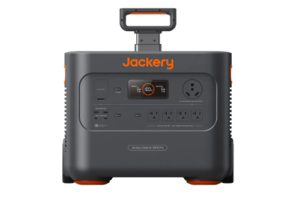
Price (UK): n/a
Price (US): $2,499 ($2,799)
Power (W): 3000
Capacity (Wh): 3024
Cell chemistry: Lithium ion
Cycle life: 2000+ to 70%
Weight: 63.9 lbs / 29 kg
Dimensions: 18.6 x 14.1 x 14.7 in
Warranty: 3+2 years
Customer rating: ⭐⭐⭐⭐⭐ (31)
Notable features:
Portable design with wheels and handle, ultra-fast charging, supports non-Jackery solar panels, pass-through charging
EcoFlow DELTA Pro

Price (UK): £2,499
Price (US): $2,699 ($4,048)
Power (W): 3600
Capacity (Wh): 3600
Cell chemistry: LiFePO₄
Cycle life: 3,500+ to 80%
Weight: 99 lbs / 44.9 kg
Dimensions: 25 x 11.2 x 16.4 in
Warranty: 5 years
Customer rating: ⭐⭐⭐⭐⭐ (472)
Notable features:
Whole home backup, scalable, MultiCharge technology, surge 7200W, X-boost 4500W, can charge at EV stations, supports dual voltage, pass-through charging
Comparison overview chart: Jackery Explorer 3000 Pro vs EcoFlow DELTA Pro
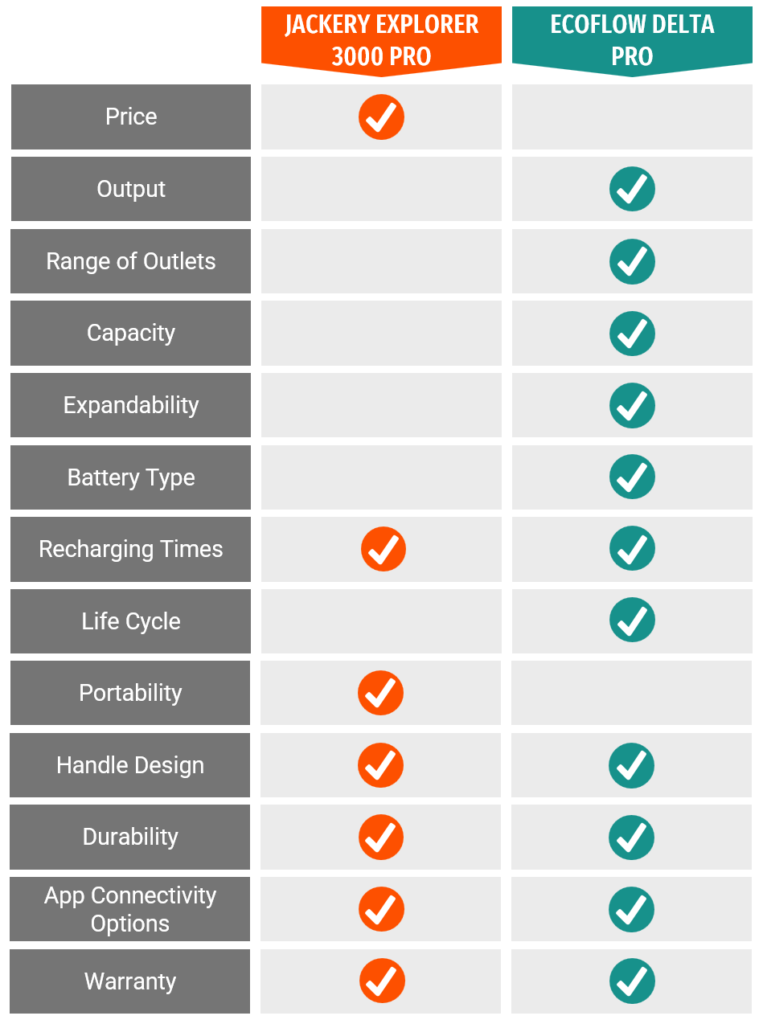
Price
At full price, the Jackery Explorer 3000 Pro has a lower price compared to the EcoFlow DELTA Pro – the Jackery Explorer 3000 Pro has a regular price of $2,799 (frequently on sale for $2,499), whilst the EcoFlow DELTA Pro has a regular price of $4,048 (but is often on sale for $2,699).
Both brands frequently put their products on sale throughout the year, so it’s always worth keeping an eye open.
Output (W)
The Jackery Explorer 3000 Pro has a base output power of 3,000W, whereas the EcoFlow DELTA Pro has a higher output of 3,600W, and can surge up to 7,200W.
The DELTA Pro also has ‘X-Boost technology’ (a feature shared by many of EcoFlow’s power stations), which means that when in use, it can support devices of up to 4,500W without overloading.
Outlet options
The EcoFlow DELTA Pro beats the Jackery Explorer 3000 Pro on outlet options, with the DELTA Pro offering a greater number as well as greater variety of outlet ports.
The Jackery Explorer 3000 Pro has the following outlet options:
- AC: 4x in total (1x for 120V~ 60Hz 25A max, and 3x for 120V~ 60Hz 20A max)
- USB-A (Quick Charge): 2x (3.0×2, 18W max)
- USB-C: 2x (100W Max, 5V⎓3A, 9V⎓3A, 12V⎓3A, 15V⎓3A, 20V⎓5A)
- Car port: 1x (12V,10A max)
The EcoFlow DELTA Pro has the following outlets:
- AC: 5x
- USB-A (standard): 2x (5V, 2.4A, 12W max per port)
- USB-A (Fast Charge): 2x (5V, 2.4A / 9V, 2A / 12V, 1.5A, 18W Max per port)
- USB-C: 2x (5/9/12/15/20V, 5A, 100W max per port)
- Car port: 1x (12.6V, 10A, 126W max)
- DC5521: 2x (12.6V, 3A, 38W max per port)
- Anderson Port: 1x (12.6V, 30)
Note: If you need to operate 240V devices with the 120V US version of the DELTA Pro, a connection of two units is necessary. This can be achieved either through the Double Voltage Hub, utilizing the AC outlets on the hub for 240V output, or by integrating with your home’s 240V outlets via a Smart Home Panel, which requires setting up 240V wiring during installation.
Note: If you want to recharge the US version of the DELTA Pro in regions with 200V-240V outlets, the standard cable provided in the US order will not be sufficient due to plug compatibility issues. To do this, you will need to purchase a third-party adapter or charging cable suitable for higher voltage outlets, ensuring that the connection adheres to local electrical standards.
Capacity (Wh)
The Jackery Explorer 3000 Pro has a substantial base capacity of 3,024Wh, however the unit is not expandable. Conversely, the EcoFlow DELTA Pro has a higher base capacity of 3,600Wh, and offers expandability of up to 25kWh with EcoFlow DELTA Pro Smart Extra Batteries and/or EcoFlow’s Dual Fuel Smart Generator.
The options for scaling up the EcoFlow DELTA Pro’s capacity are as follows:
- 3.6kWh: 1x DELTA Pro (regular)
- 7.2kWh: 1x DELTA Pro, 1x DELTA Pro Smart Extra Battery
- 10.8kWh: 1x DELTA Pro, 2x DELTA Pro Smart Extra Battery
- 12.5kWh: 1x DELTA Pro, 1x DELTA Pro Smart Extra Battery, 1x Dual Fuel Smart Generator (gasoline and LPG)
- 25kWh: 2x DELTA Pro, 2x DELTA Pro Smart Extra Battery, 2x Dual Fuel Smart Generator (gasoline and LPG)
Battery
While the Jackery Explorer 3000 Pro uses a Lithium-ion battery, the EcoFlow DELTA Pro uses a LiFePO₄ battery (lithium iron phosphate, also known as LFP) .
Each type of battery has their own pros and cons. Lithium-ion batteries are known for having a lighter weight and lower cost, but they tend to have shorter life cycles and an inferior safety profile compared to LiFePO₄ batteries.
LiFePO₄ batteries, although heavier and more costly, have longer life cycles than Li-ion batteries (in this case, the EcoFlow’s 3,500+ to 80% compared to the Jackery’s 2,000+ to 70%). Additionally, LiFePO₄ batteries are less prone to thermal runaway, making them safer and more stable, which is an important feature for high-capacity applications such as power stations.
Given these factors, despite the higher initial cost and increased weight, we generally recommend going for LiFePO₄ batteries like those used in the EcoFlow DELTA Pro due to their longer lifespan and enhanced safety profile.
Recharging options and speed
Both the Jackery Explorer 3000 Pro vs EcoFlow DELTA Pro have similar recharging options and speed, so it’s hard to determine a clear winner in this area. Overall, the DELTA Pro’s charging times seem to be slightly faster than the Explorer 3000 Pro’s, but charging times depend on geographic region as well as conditions (when it comes to solar charging, at least).
Jackery Explorer 3000 Pro
The Jackery Explorer 3000 Pro’s recharging times are as follows:
- AC input (120V, 60Hz, 15A max): 2.4 hours
- Car input (12V): 35 hours
- Solar input:
- 6x SolarSaga 200W solar panel: 3-4 hours
- 4x SolarSaga 200W solar panel: 5-6 hours
- 2x SolarSaga 200W solar panel: 9-10 hours
- 1x SolarSaga 200W solar panel: 18-19 hours
As for their solar recharging options, Jackery recommend using a combination of up to 6x SolarSaga 200W (with 2x solar panel connectors), or up to 6x SolarSaga 100W (also with 2x solar connectors). However, you can charge the Explorer 3000 Pro with any of Jackery’s 60W, 80W, 100W, or 200W solar panels.
While brands usually recommend using own-brand solar panels for recharging their portable power stations, Jackery have confirmed that the Explorer 3000 Pro can be recharged via other brands of solar panels (it accepts DC 11-60V). However, it should be noted that the same type of solar panel should be used at any one time to avoid damage due to inconsistent voltages.
EcoFlow DELTA Pro
On the other hand, the EcoFlow DELTA Pro has the following recharging times:
- AC input:
- US version (1800W max, 120V~15A): 2.7 hours
- US version (3000W max; 240V~12.5A): 1.8 hours
- International version (2900W): 1.9 hours
- 6500W MultiCharge: 2.7 hours
- Car input (12V/24V battery, 8A):
- With EcoFlow 800W Alternator Charger: 1.3 hours for 1kWh
- Solar input (1600W max, 11-150V, 15A max):
- 4x EcoFlow 400W Rigid Solar Panel: 2.3 hours
When recharging the EcoFlow DELTA Pro with solar panels, you should not exceed the maximum voltage limit of 150V. While the device can handle amperage above its capacity – dropping excess current – it’s vital to maintain the voltage within safe limits to prevent damage.
For optimal performance, using panels in parallel is recommended, which increases amperage while maintaining a consistent voltage. For instance, if using two panels each with specifications of 37 volts and 8.8 amps in parallel, the combined output remains at 37 volts but the amperage increases to 17.6 amps. The DELTA Pro will utilize up to 15 amps of this, disregarding any excess. Aim to keep the combined voltage of your solar setup around 120 volts, especially in colder conditions where voltage can increase.
Note that using other branded solar panels with the EcoFlow DELTA Pro may work, but it also may void its warranty – so proceed with caution. It’s always recommended to use same-brand solar panels to your power stations just to be on the safe side.
Charge life cycle
Due to its battery chemistry, the EcoFlow DELTA Pro has a longer charge life cycle, at 3500+ charges before dropping to 80% performance, compared to the Jackery Explorer 3000 Pro’s 2000+ charges before dropping to 70%. So the DELTA Pro is the clear winner here.
Rate and depth of discharge
Specific details about the rate and depth of discharge (DoD) for the Jackery Explorer 3000 Pro and EcoFlow DELTA Pro have not been directly provided – however, both Lithium-ion and LiFePO₄ batteries typically support a discharge rate of 1C and have a recommended DoD of around 80%.
Both the Jackery Explorer 3000 Pro and EcoFlow DELTA Pro allow for simultaneous charging and discharging.
UPS
Both the Jackery Explorer 3000 Pro and EcoFlow DELTA Pro have UPS (uninterrupted power supply) capabilities. The DELTA Pro’s UPS is given as <20ms, however there is no specific switchover speed specified for the Explorer 3000 Pro.
Loudness
The Explorer 3000 Pro and DELTA Pro have both been designed to operate quietly, so they can be used in close quarters or at night-time. The Jackery Explorer 3000 Pro uses a ‘Quiet Canyon’ cooling system, which maintains a noise level of 30dB (which is whisper-quiet) whilst keeping the power station as cool as possible. While EcoFlow haven’t specified decibel levels for the DELTA Pro, it’s also very quiet – only one review out of 470+ mentioned it getting a little noisy with 900W+ of solar input, but this was a very minor drawback for that customer. All the other reviews that mention loudness talk about it being very quiet, if not silent.
Portability
Weight and size
Looking at weight first: the Jackery Explorer 3000 Pro is the lightest of the two, weighing 63.93 lbs (29 kg), compared to the EcoFlow DELTA Pro at 99 lbs (45 kg). This is unsurprising, as Lithium-ion batteries (which the Explorer 3000 Pro uses) are typically much lighter than their LFP counterparts.
In terms of size, the Jackery Explorer 3000 Pro is also slightly smaller, measuring 18.6 x 14.1 x 14.7 inches (47.24 x 35.81 x 37.34 cm) compared to the EcoFlow DELTA Pro at 25 x 11.2 x 16.4 inches (63.5 x 28.5 x 42 cm). Both power stations have built-in extendable handles, which will be discussed below.
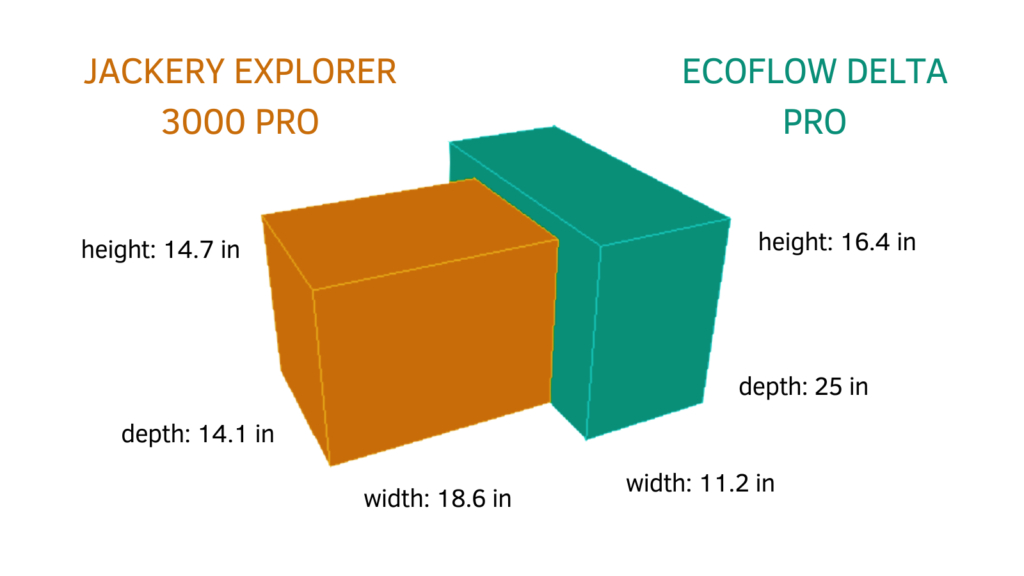
Handle design
Both the Explorer 3000 Pro and the DELTA Pro have wheels at the back of the unit, two built-in side handles, and an expandable handle to aid portability.
The main differences are in the positioning of the handles: the Jackery unit has its handles on either side of the power station, and are built into the flat dimensions of the unit, while the EcoFlow unit has its handles at the front and back, and they protrude out of the power station’s dimensions rather than fitting inside the dimensions. The debate of ‘build-in’ versus ‘protruding’ handles is a matter of personal preference, but it’s something to consider when thinking about carrying with one hand, carrying with two hands, and storage/transportation.
The other difference is that the Explorer 3000 Pro’s extendable handle comes out the top of the unit’s rear, while the DELTA Pro’s extendable handle comes out the bottom of its front side. Again, this difference is minor, but possibly something to consider.
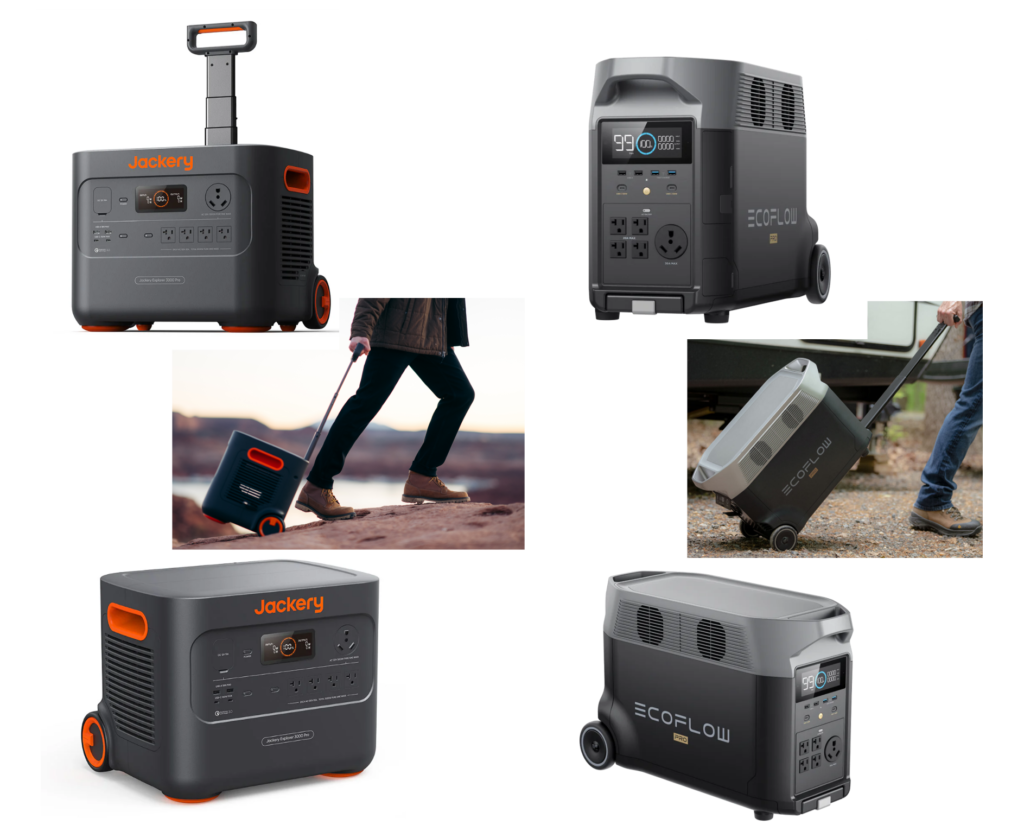
Durability
Comparing durability features for the Jackery Explorer 3000 Pro vs EcoFlow DELTA Pro, it’s pretty much a tie. Both power stations have BMS (Battery Management System) which provides multiple forms of regulation and protection including over-voltage, over-current, over-temperature, and short circuit protection.
As we’ve discussed earlier, in terms of life cycles (and general safety features), the EcoFlow DELTA Pro comes out on top, having a longer life cycle than the Explorer 3000 Pro and a generally superior safety profile by virtue of its LiFePO₄ battery chemistry.
Neither unit is waterproof, and specific dust resistance ratings are not provided, indicating that both are better suited for use in clean, dry environments.
In terms of temperature, Jackery have specified an operating temperature range of -4°F to 104°F (-20°C to 40°C). EcoFlow’s DELTA Pro manual gives a range of similar temperatures for optimal operating, discharging, charging, and storing, which are as follows:
- Optimal operating temperature: 68°F to 86°F (20°C to 30°C)
- Discharge temperature: 14°F to 113°F (-10°C to 45°C)
- Charge temperature: 32°F to 113°F (0°C to 45°C)
- Storage temperature: 14°F to 113°F (optimal: 68°F to 86°F) (-10°C to 45°C; optimal: 20°C to 30°C)
App control and connectivity
Both the Jackery Explorer 3000 Pro and the EcoFlow DELTA Pro have smartphone app control and connectivity via Bluetooth and Wi-Fi. The apps both let you monitor your power station’s performance, allowing you to keep an eye on data including real-time power input and output, battery health, estimated runtime, and historical usage data. The apps can also be used to switch between different battery modes to optimize battery life.
In terms of usability, we haven’t had a chance to try the Jackery app yet, but we have tried the EcoFlow app and found it very easy to set up and intuitive to use (see this video for a walkthrough of the app). (One tip which might come in handy: if you’re struggling to connect to Wi-Fi, try turning off mobile data first.)
Warranty
Both power stations have a total 5 year warranty, which includes the basic warranty plus warranty extension.
To break this down, the Jackery Explorer 3000 Pro has a basic 3 year warranty + 2 year extended warranty, which is automatically applied if purchased directly from Jackery – see their policy terms for full details. The EcoFlow DELTA Pro has a ’24+36′ month warranty, which means you get 2 years basic warranty plus an additional 3 years if you register for warranty extension – see EcoFlow’s policy terms.
Full comparison table
Jackery Explorer 3000 Pro vs EcoFlow DELTA Pro specifications
| Feature | Jackery Explorer 3000 Pro | EcoFlow DELTA Pro |
| AC Output (W) | 3000 | 3600 (4500 with X-boost) |
| Surge Power (W) | n/a | 7200 |
| Battery Capacity (Wh) | 3024 | 3600 |
| Expandable Capacity | No | Yes (up to 25kWh) |
| Battery Type | Lithium-ion | LiFePO₄ |
| Life Cycles | 2000+ to 70% | 3500+ to 80% |
| AC Outlets | 4x | 5x |
| USB-A Outlets | 2x | 4x |
| USB-C Outlets | 2x | 2x |
| Car Outlets | 1x | 1x |
| Additional Outlets | None | 2x DC5521, 1x Anderson |
| Solar Charging | 3-4 hours optimal (1400W max) | 2.3 hours optimal (1600W max) |
| AC Charging | 2.4 hours | 1.8 hours optimal (3000W max) |
| Car Charging | 35 hours | Not specified, but faster (especially with 800W Alternator Charger) |
| Weight (lbs) | ~64 | ~99 |
| Dimensions (in) | 18.6 x 14.1 x 14.7 | 25 x 11.2 x 16.4 |
| Smart App Control | Yes (Wi-Fi and Bluetooth) | Yes (Wi-Fi and Bluetooth) |
| Warranty | 3+2 years | 2+3 years |
Full comparison table of features for the Jackery Explorer 3000 Pro vs EcoFlow DELTA Pro.
Customer reviews
In terms of customer reviews for the Jackery Explorer 3000 Pro vs EcoFlow DELTA Pro, both models currently have exceptionally high ratings from real-world customers. At the time of writing, the Explorer 3000 Pro is averaging 4.81/5, and the DELTA Pro is averaging 4.9/5.
We have compiled the most common customer feedback for you to review below, which we sourced from both the US and the UK product pages (where available).
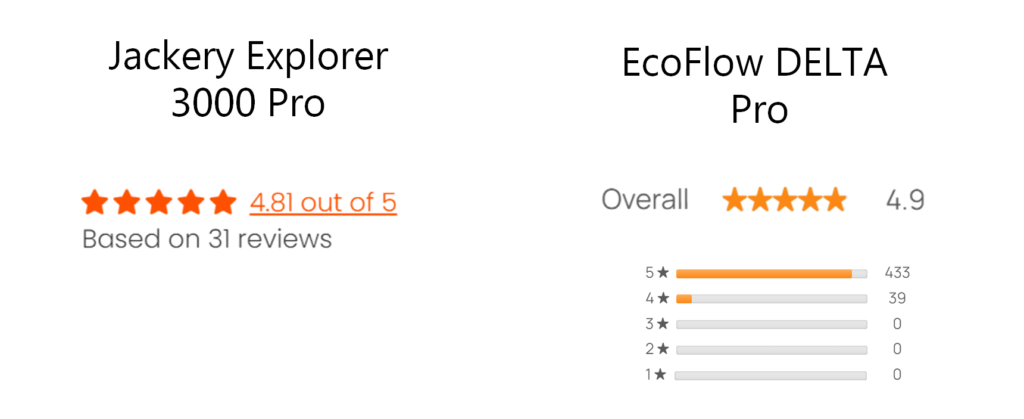
Jackery Explorer 3000 Pro: ⭐⭐⭐⭐⭐ (31)
- ✅ Power and versatility: Many reviews mentioned successfully running high-wattage appliances such as air conditioners, refrigerators, and even CPAP machines during power outages.
- ✅ Easy setup and use: Customers thought the setup was straightforward and intuitive, making it suitable for all users, regardless of technical expertise, which is particularly valuable in emergency situations.
- ✅ Self-sufficiency: The ability to connect multiple solar panels for quick recharging was frequently mentioned in reviews, with customers enjoying the freedom of being able to remain power independent during extended off-grid periods.
- ✅ Portable: The design features like the retractable handle and sturdy wheels were often mentioned in the context of travel, with users finding it easy to maneuver on camping grounds and during road trips.
- ✅ Good customer service: Several reviews commended Jackery’s responsive and helpful customer service.
- ❌ Security concerns: A few customers suggested design improvements for securing the unit outdoors, such as adding a lock feature to prevent theft.
- ❌ Heavy: While portable, some found the unit’s 64 lbs weight to be challenging when trying to move it without the help of wheels, especially when loading and unloading from vehicles.
- ❌ Initial Cost: The upfront cost of the unit, while justified by its performance, was described as steep by some (especially for those making their first foray into portable/solar power solutions).
- ❌ App issues: Despite the overall positive view of the app, some customers noted occasional glitches and asked for more updates to the app to improve overall usability.
- ❌ Charging limitations: A few customers noted that the unit could trip circuit breakers when charging from certain domestic outlets, suggesting the need for careful selection of charging locations within the home.
- Pre-charge before use: Ensure the power station is fully charged before heading out, especially for camping or emergency backups.
- App connectivity: Pair your device with the app immediately after setup for easier control and status updates.
- Use slow charging for battery longevity: When not in urgent need of a fast recharge, use the slow charging mode to extend the battery’s lifespan.
- Battery saving mode: Enable battery saving mode via the app to prevent overcharging and deep discharging, helping preserve the battery’s health over time.
- Secure it: If using the unit outdoors or in public spaces, consider ways to secure it to prevent theft, such as chaining it to something fixed.
- Ventilation for cooling: Ensure the power station is placed in a well-ventilated area during use to prevent overheating (especially when running high-wattage appliances).
EcoFlow DELTA Pro: ⭐⭐⭐⭐⭐ (472)
- ✅ Reliable and high-power: Many customers talk about using the DELTA Pro for during extended power outages, such as during hurricanes, and its ability to run high-wattage appliances like air conditioners.
- ✅ Efficient charging with solar panels: The ability to charge quickly and effectively with solar panels is mentioned frequently.
- ✅ Portable design: The portable suitcase-like design with wheels makes it easy to move, which is especially appreciated by RV users and those who use it for mobile businesses like coffee roasting on road trips.
- ✅ App functionality: The smartphone app goes down very well with the majority of customers, who use it for monitoring and adjusting settings remotely.
- ✅ Expandability: The capability to expand the system with additional batteries and integrate it into home setups with the Smart Home Panel is mentioned as a significant advantage for those looking to scale.
- ❌ Heavy weight and mobility issues: Despite its wheels, some customers found the unit quite heavy, especially when needing to lift it into vehicles or move it upstairs.
- ❌ Initial setup complexity: A few users noted challenges with initial setup, particularly with integrating additional components like extra batteries and solar panels.
- ❌ Customer service delays: There are mentions of delays in customer service response times, especially when dealing with complex issues or when needing replacement parts.
- ❌ Firmware and app bugs: Some customers experienced glitches with using the app for firmware updates, mentioning occasional difficulties with updates and connectivity.
- ❌ Security concerns: Like the Jackery model, the lack of a secure locking feature has been a concern for customer who need to leave the power station unattended outdoors.
- Optimizing app connectivity: For reliable monitoring and control via the EcoFlow app, using the built-in WiFi connection is recommended for the best experience. However, if the EcoFlow unit lacks internet access, the Bluetooth connection might not be sufficient for adequate monitoring. You should make sure your EcoFlow unit is connected to your home Wi-Fi network for seamless operation. If you don’t have Wi-Fi and only have mobile data, consider a direct Ethernet connection to the EcoFlow unit to maintain consistent data flow and app functionality.
- Power management: Make use of the app’s ability to control the charging rate to avoid overloading less capable circuits, especially when connected to limited-capacity sources.
- Extra security: Since the DELTA Pro is pretty pricey, consider taking additional security measures if leaving it outside or in public spaces, like chaining it or placing it in a secure enclosure.
- Maximizing battery life: Use the battery saving mode available through the app to extend the life cycle of the unit by limiting the charge to 85% and not allowing the battery to drain below 15%.
Backup for critical appliances: Test the DELTA Pro with critical appliances like refrigerators or medical devices before relying on it in an emergency to ensure compatibility and capacity needs are met.
Purchase options
There are various purchase options for both the Jackery Explorer 3000 Pro and the EcoFlow DELTA Pro, including bundle packages and add-ons, which mean you can tailor your set-up to meet your specific requirements.
Tip: always check the main product pages for the Jackery Explorer 3000 Pro and the EcoFlow DELTA Pro to see if there are bundle/add-on options available at a discount before you order the items separately!
Jackery Explorer 3000 Pro purchase options:
- Explorer 3000 Pro
- Explorer 3000 Pro + Transfer Switch
- Solar Generator 3000 Pro (the same Explorer 3000 Pro portable power station, but with different combinations of solar panels included)
Compatible accessories and add-ons:
EcoFlow DELTA Pro purchase options:
- DELTA Pro (+ Free Transfer Switch)
- DELTA Pro + 220W Portable Solar Panel + Free DELTA Pro Bag
- DELTA Pro + DELTA Pro Smart Extra Battery + Free Transfer Switch
- DELTA Pro + 800W Alternator Charger
- DELTA Pro + 400W Portable Solar Panel + Free Transfer Switch
- DELTA Pro + 400W Rigid Solar Panel (2x or 4x)
- DELTA Pro + Smart Fuel Generator (dual fuel; gasoline + LPG)
Compatible accessories and add-ons:
- 220W Portable Solar Panel
- 400W Portable Solar Panel
- DELTA Pro Smart Extra Battery (just the Smart Extra Battery)
- 800W Alternator Charger
- Smart Fuel Generator (dual fuel; gasoline + LPG)
- DELTA Pro Bag
- DELTA Pro Keyring (we’re not making this up… UK only I’m afraid!)
Conclusion: Jackery Explorer 3000 Pro vs EcoFlow DELTA Pro
The final question – which one do we recommend?
The Explorer 3000 Pro and DELTA Pro are both excellent portable power stations in their own right. There are hundreds of happy customers who will testify this and very few who will disagree. While neither models are particularly ‘environmentally durable’ (both lacking any IP ratings for water and dust resistance), making them more suited to dry or sheltered outdoor use – or indoor use, of course – they both pack a significant punch when it comes to capacity and wattage.
If we have to choose a winner, we vote for the EcoFlow DELTA Pro on this occasion. Although it’s a bit pricier than the Jackery alternative, it has the clear benefits of it being safer and longer lasting due to its LiFePO₄ battery, and it’s also expandable with additional batteries, which means you have the flexibility to scale up your power setup in the future. Also, if you’re lucky enough to catch the DELTA Pro when it’s on sale (which seems to be at least 50% of the time!), its price difference to the Explorer 3000 Pro is negligible.
However, as always, your personal circumstances and preferences may sway you towards the Jackery, which is perfectly fine.
Jackery Explorer 3000 Pro vs EcoFlow DELTA Pro: Final Thoughts
In summary:
- If you’re concerned about safety and longevity: EcoFlow DELTA Pro
- If you live in the UK: EcoFlow DELTA Pro
- If you want the lighter option: Jackery Explorer 3000 Pro
- If expandability is important: EcoFlow DELTA Pro
- For faster solar charging: EcoFlow DELTA Pro
- If your main concern is cost: Jackery Explorer 3000 Pro
We hope this comparison article has helped make your choice between the Jackery Explorer 3000 Pro and the EcoFlow DELTA Pro clearer!
For further reading, you may be interested in:
Solar Trek is all about breaking down information about solar-powered brands and products into a helpful, easily digestible format. All of our content is totally objective, aimed at helping you to make the best purchasing decisions for your solar needs. If you click our links and make a purchase, we may earn some commission at absolutely no extra cost to you, but this does not interfere with our goals of providing 100% helpful, informative, and objective information.


